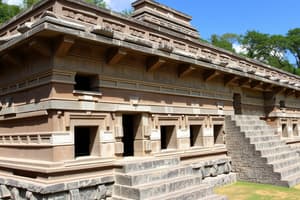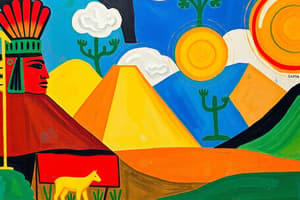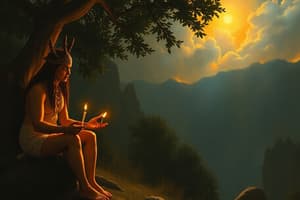Podcast
Questions and Answers
Where was the Inca religion based?
Where was the Inca religion based?
- Europe
- North America
- Central America
- Andes region in South America (correct)
When did the Inca religion reign until?
When did the Inca religion reign until?
- 1500-1600 AD
- 1300-1400 AD
- 1400-1500 AD
- 1438-1533 AD (correct)
Who led the taking over of the Inca empire?
Who led the taking over of the Inca empire?
- Christopher Columbus
- Hernán Cortés
- Francisco Pizarro (correct)
- Ferdinand Magellan
Which modern countries were covered by the Inca religion?
Which modern countries were covered by the Inca religion?
What was the role of religion in Inca society?
What was the role of religion in Inca society?
Which ancient civilization settled in modern-day Mexico first?
Which ancient civilization settled in modern-day Mexico first?
What was the main method of record-keeping used by the Inca civilization?
What was the main method of record-keeping used by the Inca civilization?
What factor contributed to the defeat of the Inca civilization when the Spanish invaded?
What factor contributed to the defeat of the Inca civilization when the Spanish invaded?
How did the Incas transmit messages throughout their empire?
How did the Incas transmit messages throughout their empire?
What purpose did religion serve in Inca society?
What purpose did religion serve in Inca society?
What was a notable feature of the Inca civilization's road system?
What was a notable feature of the Inca civilization's road system?
What was the primary purpose of the way stations along the Inca roads?
What was the primary purpose of the way stations along the Inca roads?
Which factor contributed to the downfall of the Inca civilization in 1533?
Which factor contributed to the downfall of the Inca civilization in 1533?
What was a unique feature of Inca religious practices?
What was a unique feature of Inca religious practices?
How did the Incas keep track of their mythology and religious beliefs for future generations?
How did the Incas keep track of their mythology and religious beliefs for future generations?
What was a significant aspect of Inca religious beliefs in relation to community life?
What was a significant aspect of Inca religious beliefs in relation to community life?
The Inca religion was based in ancient ______, Peru.
The Inca religion was based in ancient ______, Peru.
Francisco Pizarro, a Spanish ______, led the taking over of the Inca empire.
Francisco Pizarro, a Spanish ______, led the taking over of the Inca empire.
The Inca religion reigned from 1438-1533 until ______, a Spanish conquistador, led the taking over of the Inca empire.
The Inca religion reigned from 1438-1533 until ______, a Spanish conquistador, led the taking over of the Inca empire.
The Inca religion was located all along the far left side of the South American coastline, covering places now known as ______, Bolivia, and Chile.
The Inca religion was located all along the far left side of the South American coastline, covering places now known as ______, Bolivia, and Chile.
The Olmec, Mayan, Incan, and Aztec civilizations are some of the greatest ancient civilizations in history, and yet we know very little about them compared to other parts of the world. The Olmecs are frequently forgotten entirely, and the rest are often lumped together or confused, but they were all completely ______.
The Olmec, Mayan, Incan, and Aztec civilizations are some of the greatest ancient civilizations in history, and yet we know very little about them compared to other parts of the world. The Olmecs are frequently forgotten entirely, and the rest are often lumped together or confused, but they were all completely ______.
The Maya came first, and settled in modern-day ______.
The Maya came first, and settled in modern-day ______.
The Inca civilisation can be traced back to about A.D. 1200. They lived in the mountains of ______, far removed from the Olmecs, Maya, and Aztecs
The Inca civilisation can be traced back to about A.D. 1200. They lived in the mountains of ______, far removed from the Olmecs, Maya, and Aztecs
At the peak of their power, the Inca civilisation extended for 4,000 kilometres (2,500 mi) and included 16 million ______.
At the peak of their power, the Inca civilisation extended for 4,000 kilometres (2,500 mi) and included 16 million ______.
They were extremely advanced and had an army, laws, roads, bridges, tunnels, and a complicated ______ system far ahead of its time.
They were extremely advanced and had an army, laws, roads, bridges, tunnels, and a complicated ______ system far ahead of its time.
The Inca never invented a system of ______, instead using knotted ropes for record-keeping (called a “quipu”).
The Inca never invented a system of ______, instead using knotted ropes for record-keeping (called a “quipu”).
A civil war over the rightful heir to the throne meant that when the Spanish invaded, the Inca were easily ______.
A civil war over the rightful heir to the throne meant that when the Spanish invaded, the Inca were easily ______.
A complex system of roads (around 10,00 miles) was built throughout the empire with bridges and ______.
A complex system of roads (around 10,00 miles) was built throughout the empire with bridges and ______.
The Incas probably had around 10,000 way stations throughout the ______.
The Incas probably had around 10,000 way stations throughout the ______.
Religion was inseparable from politics, history, and society in general for the ______.
Religion was inseparable from politics, history, and society in general for the ______.
It was thought that the gods and the Inca’s ancestors influenced success and failures of any kind in ______.
It was thought that the gods and the Inca’s ancestors influenced success and failures of any kind in ______.
Religion was also an important tool for the ruling elite to legitimize their privileged position within society and to spread the general belief of Inca superiority over the subjects of their ______.
Religion was also an important tool for the ruling elite to legitimize their privileged position within society and to spread the general belief of Inca superiority over the subjects of their ______.
Flashcards are hidden until you start studying




